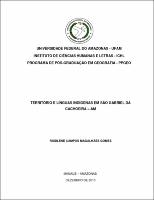| ???jsp.display-item.social.title??? |


|
Please use this identifier to cite or link to this item:
https://tede.ufam.edu.br/handle/tede/3955Full metadata record
| DC Field | Value | Language |
|---|---|---|
| dc.creator | Gomes, Rosilene Campos Magalhães | - |
| dc.creator.Lattes | http://lattes.cnpq.br/9294292385271711 | por |
| dc.contributor.advisor1 | Faria, Ivani Ferreira de | - |
| dc.contributor.advisor1Lattes | http://lattes.cnpq.br/9910677483036522 | por |
| dc.date.issued | 2013-12-12 | - |
| dc.identifier.citation | GOMES, Rosilene Campos Magalhães. Território e línguas indígenas em São Gabriel da Cachoeira-AM. 2013. 127 f. Dissertação (Mestrado em Geografia) - Universidade Federal do Amazonas, Manaus, 2013. | por |
| dc.identifier.uri | http://tede.ufam.edu.br/handle/tede/3955 | - |
| dc.description.resumo | Esta pesquisa analisa a territorialização das línguas indígenas na sede do Município de São Gabriel da Cachoeira – AM, uma vez que foi o município pioneiro na co-oficializaçao das línguas indígenas Tukano, Baniwa e Nheengatu no Brasil em 2002, seguido por outros municípios que oficializaram não só línguas indígenas, mas também línguas de migração. O município é constituído por 23 povos indígenas pertencentes a cinco famílias linguísticas Tukano Oriental, Aruak, Yanomami, Japurá-Uaupés (Maku) e Tupi (Nheengatu falado pelos povos Baré, Werekena e parte dos Baniwa do baixo rio Içana), falantes entre 20 a 23 línguas indígenas. A base conceitual da pesquisa está centrada nas categorias de Território, Língua e Cultura Indígena, Sociolinguística, Geografia e a Linguística. Tendo sido utilizado ainda, de procedimentos metodológicos da pesquisa participante e levantamento de fontes primárias e secundárias. Neste contexto, a pesquisa visou compreender a territorialização das línguas indígenas na sede de São Gabriel da Cachoeira, por meio da identificação dos lugares de uso das línguas, analisando a territorialização das mesmas no meio urbano e verificando quais os mecanismos usados pelos povos, setor público e sociedade civil organizada para valorização e manutenção e reprodução das línguas, uma vez que, a língua para os povos indígenas do Alto Rio Negro, é um dos elementos mais fortes de sua cultura. Para permear, revitalizar e sustentar a manutenção das línguas indígenas no município é preciso, fundamentalmente, colocar em prática a lei de co-oficialização das línguas indígenas existentes neste município, recuperar o prestígio e o status dessas línguas, de modo que, os falantes mais jovens, órgãos públicos e privados possam utilizá-las diariamente, assim como, nas escolas, para que se revertam os fenômenos de substituição e perda linguísticas que tais línguas indígenas vêm sofrendo. | por |
| dc.description.abstract | This dissertation analyzes on the territorialization of indigenous languages in the region of São Gabriel da Cachoeira – AM, once the region has pioneered in the municipality at the co-oficilização of indigenous languages Tukano, Baniwa and Nheengatu in Brazil in 2002, followed by other region that formalize not only indigenous languages as well as migration languages. The municipality is consists of 23 crowd from five language families Eastern Tukano Aruak Yanomami Japurá-Uaupes (Maku) and Tupi (Nheengatu spoken by people Baré, Werekena, and part of the people Baniwa of lower river Içana) that are speakers between 20 at the 23 indigenous languages. The conceptual basis of the research is focused on categories as Territory, Indigenous Language and Culture, Sociolinguistics, Geography and Linguistics. We used the methodological procedures of participatory research with raising basic primary and secondary sources. In this context, the research searched understand the territorialization of indigenous languages at the urban areas of the municipality, by way the identification of the places where languages are used, analyzing its territorialisation in urban place and checking what mechanisms used by people, public sector and civil society organizations for recovery and maintenance and reproduction of the languages, since the language for the indigenous peoples of the High Rio Negro is one of the strongest elements of your culture. To permeate, revitalize and sustain the maintenance of indigenous languages in the municipality is need, fundamentally, to put into practice the law of co-official languages of the indigenous existing in this municipality, recover the prestige at the status of these languages, so that the youngest speakers, public and private to can use them daily, as well as in schools, so to reverse the phenomena of language replacement and linguistics loss that these such indigenous languages come having. | eng |
| dc.description.sponsorship | CAPES - Coordenação de Aperfeiçoamento de Pessoal de Nível Superior | por |
| dc.format | application/pdf | * |
| dc.thumbnail.url | http://200.129.163.131:8080//retrieve/8588/Dissertacao-%20Rosilene%20Campos%20Magalh%c3%a3es%20Gomes.pdf.jpg | * |
| dc.language | por | por |
| dc.publisher | Universidade Federal do Amazonas | por |
| dc.publisher.department | Instituto de Ciências Humanas e Letras | por |
| dc.publisher.country | Brasil | por |
| dc.publisher.initials | UFAM | por |
| dc.publisher.program | Programa de Pós-graduação em Geografia | por |
| dc.rights | Acesso Aberto | por |
| dc.subject | Línguas Indígenas | por |
| dc.subject | Território | por |
| dc.subject | Alto Rio Negro | por |
| dc.subject | Geografia | por |
| dc.subject | Indigenous Languages | eng |
| dc.subject | Territory | eng |
| dc.subject.cnpq | CIÊNCIAS HUMANAS: GEOGRAFIA | por |
| dc.title | Território e línguas indígenas em São Gabriel da Cachoeira-AM | por |
| dc.type | Dissertação | por |
| Appears in Collections: | Mestrado em Geografia | |
Files in This Item:
| File | Description | Size | Format | |
|---|---|---|---|---|
| Dissertacao- Rosilene Campos Magalhães Gomes.pdf | Dissertacao- Rosilene Campos Magalhães Gomes | 2.93 MB | Adobe PDF |  Download/Open Preview |
Items in DSpace are protected by copyright, with all rights reserved, unless otherwise indicated.




